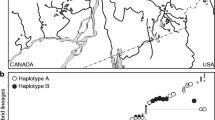Abstract
By definition, organisms of hybrid ancestry carry amalgamations of divergent genomes. Thus, exaggerated effects of genomic interactions might be anticipated in hybrid populations, thereby magnifying the impact of natural selection and making this and other evolutionary forces easier to document. Mating biases and other gender-based asymmetries also frequently characterize hybrid populations. Thus, maternally inherited cytoplasmic polymorphisms assayed jointly with those at biparentally inherited nuclear loci provide powerful genetic markers to dissect ethological, ecological, and evolutionary processes in hybrid settings. Population-level topics that can be addressed using cytonuclear markers include the frequency of hybridization and introgression in nature, behavioral and ecological factors (such as mating preferences and hybrid fitnesses) influencing the genetic architectures of hybrid zones, the degree of consistency in genetic outcomes across multiple hybrid contact regions, and environmental impacts (including the introduction of alien species) on hybridization processes. Several empirical studies on fish populations in hybrid settings illustrate the application of cytonuclear appraisals in such contexts.
Similar content being viewed by others
References
Allendorf F.W. and Leary R.F. (1988) Conservation and distribution of genetic variation in a polytypic species, the cutthroat trout. Cons. Biol. 2, 170–184.
Arnold J. (1993) Cytonuclear disequilibria in hybrid zones. Annu. Rev. Ecol. Syst. 24, 521–554.
Arnold J., Asmussen M.A. and Avise J.C. (1988) An epistatic mating system model can produce permanent cytonuclear disequilibria in a hybrid zone. Proc. Natl. Acad. Sci. USA 85, 1893–1896.
Asmussen M.A., Arnold J. and Avise J.C. (1987) Definition and properties of disequilibrium statistics for associations between nuclear and cytoplasmic genotypes. Genetics 115, 755–768.
Asmussen M.A., Arnold J. and Avise J.C. (1989) The effects of assortative mating and migration on cytonuclear associations in hybrid zones. Genetics 122, 923–934.
Asmussen M.A. and Basten C.J. (1994) Sampling theory for cytonuclear disequilibria. Genetics 138, 1351–1363.
Avise J.C. (1994) Molecular Markers, Natural History and Evolution. Chapman & Hall, New York.
Avise J.C. (2000) Phylogeography: The History and Formation of Species. Harvard University Press, Cambridge, MA.
Avise J.C., Bermingham E., Kessler L.G. and Saunders N.C. (1984) Characterization of mitochondrial DNA variability in a hybrid swarm between subspecies of bluegill sunfish (Lepomis macrochirus). Evolution 38, 931–941.
Avise J.C., Pierce P.C., Van Den Avyle M.J., Smith M.H., Nelson W.S. and Asmussen M.A. (1997) Cytonuclear introgressive swamping and species turnover of bass after an introduction. J. Heredity 88, 14–20.
Avise J.C. and Saunders N.C. (1984) Hybridization and introgression among species of sunfish (Lepomis): Analysis by mitochondrial DNA and allozyme markers. Genetics 108, 237–255.
Avise J.C. and Smith M.H. (1974) Biochemical genetics of sunfish II. Genic similarity between hybridizing species. Amer. Natur. 108, 458–472.
Childers W.F. (1967) Hybridization of four species of sunfishes (Centrarchidae). Bull. Ill. Nat. Hist. Surv. 29, 159–214.
Clark A.G. (1984) Natural selection with nuclear and cytoplasmic transmission. I. A deterministic model. Genetics 107, 679–701.
Dowling T.E. and Secor C.L. (1997) The role of hybridization and introgression in the diversification of animals. Annu. Rev. Ecol. Syst. 28, 593–619.
Epifanio J.M. and Philipp D.P. (1997) Sources for misclassifying genealogical origins in mixed hybrid populations. J. Heredity 88, 62–65.
Forbes S.H. and Allendorf F.W. (1991) Associations between mitochondrial and nuclear genotypes in cutthroat trout hybrid swarms. Evolution 45, 1332–1349.
Haldane J.B.S. (1922) Sex ratio and the unisexual sterility of hybrid animals. J. Genet. 12, 101–109.
Lamb T. and Avise J.C. (1986) Directional introgression of mitochondrial DNA in a hybrid population of treefrogs: the influence of mating behavior. Proc. Natl. Acad. Sci. USA 83, 2526–2530.
Lamb T. and Avise J.C. (1987) Morphological variability in genetically-defined categories of anuran hybrids. Evolution 41, 157–165.
Leary R.F., Allendorf F.W. and Forbes S.H. (1993) Conservation genetics of bull trout in the Columbia and Klamath River drainages. Cons. Biol. 7, 856–865.
Mecham J.S. (1960) Introgressive hybridization between two southeastern treefrogs. Evolution 39, 1318–1326.
Rymer J.M. and Simberloff D. (1996) Extinction by hybridization and introgression. Annu. Rev. Ecol. Syst. 27, 83–109.
Scribner K.T. (2000) Cytonuclear models of evolutionary change within Gambusia hybrid zones: the relative importance of life history and behavioral ecological phenomena. Rev. Fish Biol. Fisheries, in press.
Scribner K.T. and Avise J.C. (1993a) Cytonuclear genetic architecture in mosquitofish populations and the possible roles of introgressive hybridization. Mol. Ecol. 2, 139–149.
Scribner K.T. and Avise J.C. (1993b) Demographic and life-history characteristics influence the cytonuclear genetic composition of mosquitofish hybrid populations. In: Beaumont A.R. (ed.), Genetics and Evolution of Aquatic Organisms. Chapman & Hall, New York, pp. 280–290.
Scribner K.T. and Avise J.C. (1994a) Population cage experiments with a vertebrate: the temporal demography and cytonuclear genetics of hybridization in Gambusia fishes. Evolution 48, 155–171.
Scribner K.T. and Avise J.C. (1994b) Cytonuclear genetics of experimental fish hybrid zones inside Biosphere 2. Proc. Natl. Acad. Sci. USA 91, 5066–5069.
Author information
Authors and Affiliations
Rights and permissions
About this article
Cite this article
Avise, J.C. Cytonuclear genetic signatures of hybridization phenomena: Rationale, utility, and empirical examples from fishes and other aquatic animals. Reviews in Fish Biology and Fisheries 10, 253–263 (2000). https://doi.org/10.1023/A:1016685509431
Issue Date:
DOI: https://doi.org/10.1023/A:1016685509431




